Abstract
1. The intravenous injection of para-methoxyphenylethylamine (PMPEA) into cats produces an increase in the size of the spinal cord monosynaptic reflex. The reflex elevation occurs within 30 s of drug administration, reaches a peak within 2 min, and lasts about 20 min.
2. The action of PMPEA is similar for extensor (gastrocnemius-soleus) and flexor (posterior biceps-semitendinosus) monosynaptic reflexes.
3. Repeated doses of PMPEA give comparable effects. The degree of monosynaptic reflex elevation is dose related.
4. The action of PMPEA is antagonized by phenoxybenzamine and by methysergide or cyproheptadine. The combination of phenoxybenzamine with either of the latter is particularly effective in preventing the reflex facilitation by PMPEA.
5. It is concluded that PMPEA has a central action on the spinal cord. It seems likely that monoaminergic synapses are involved.
Full text
PDF



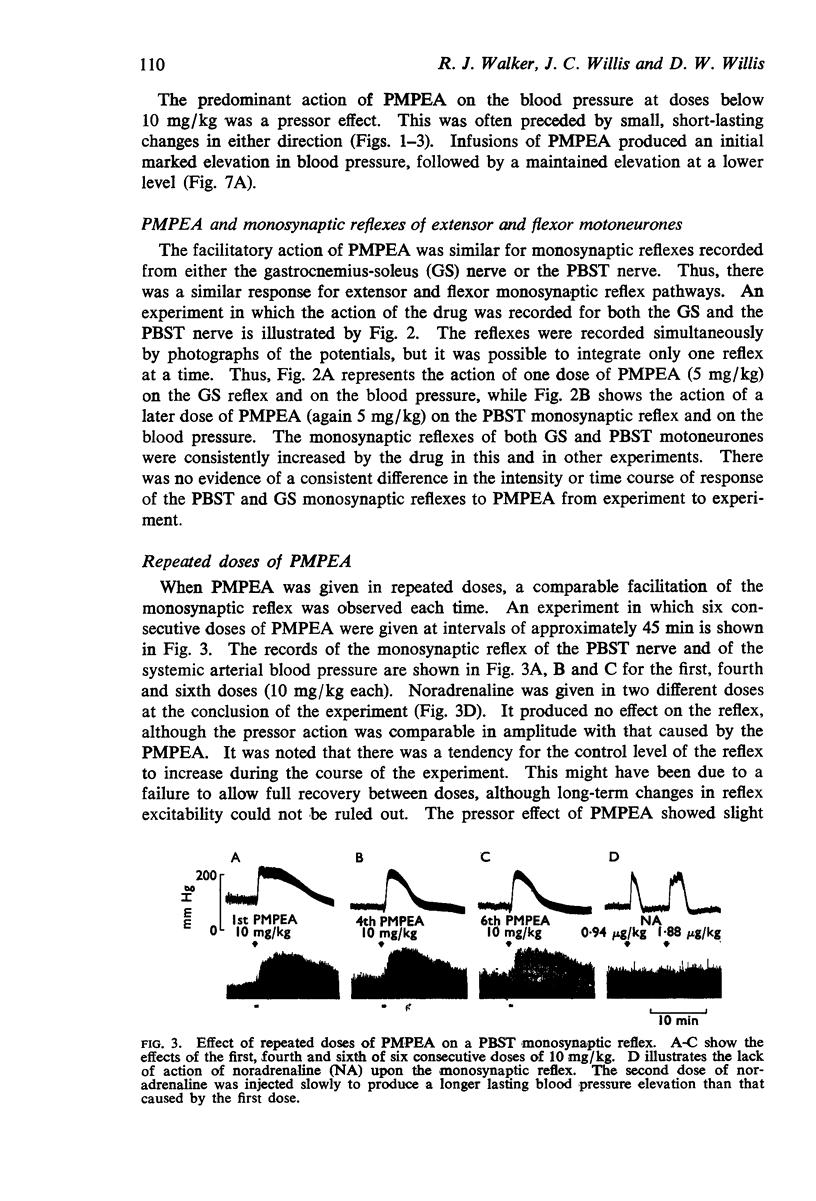

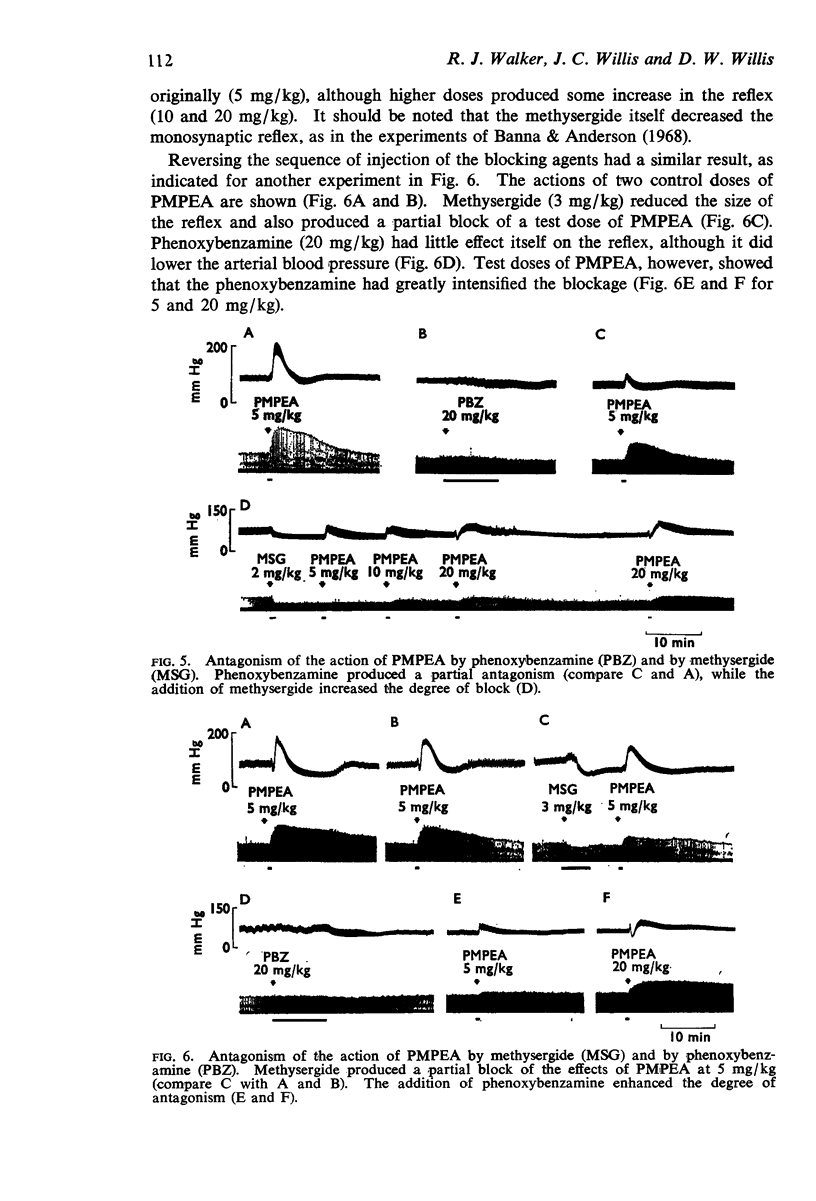
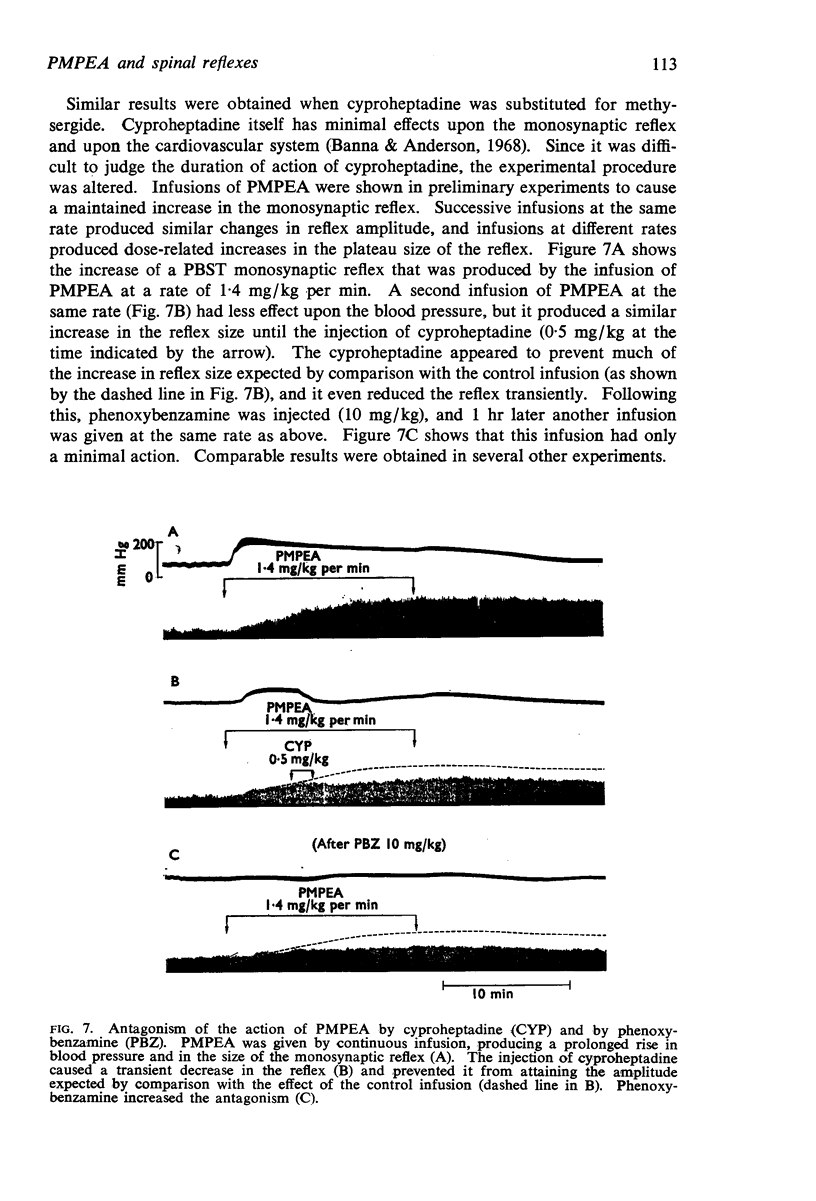
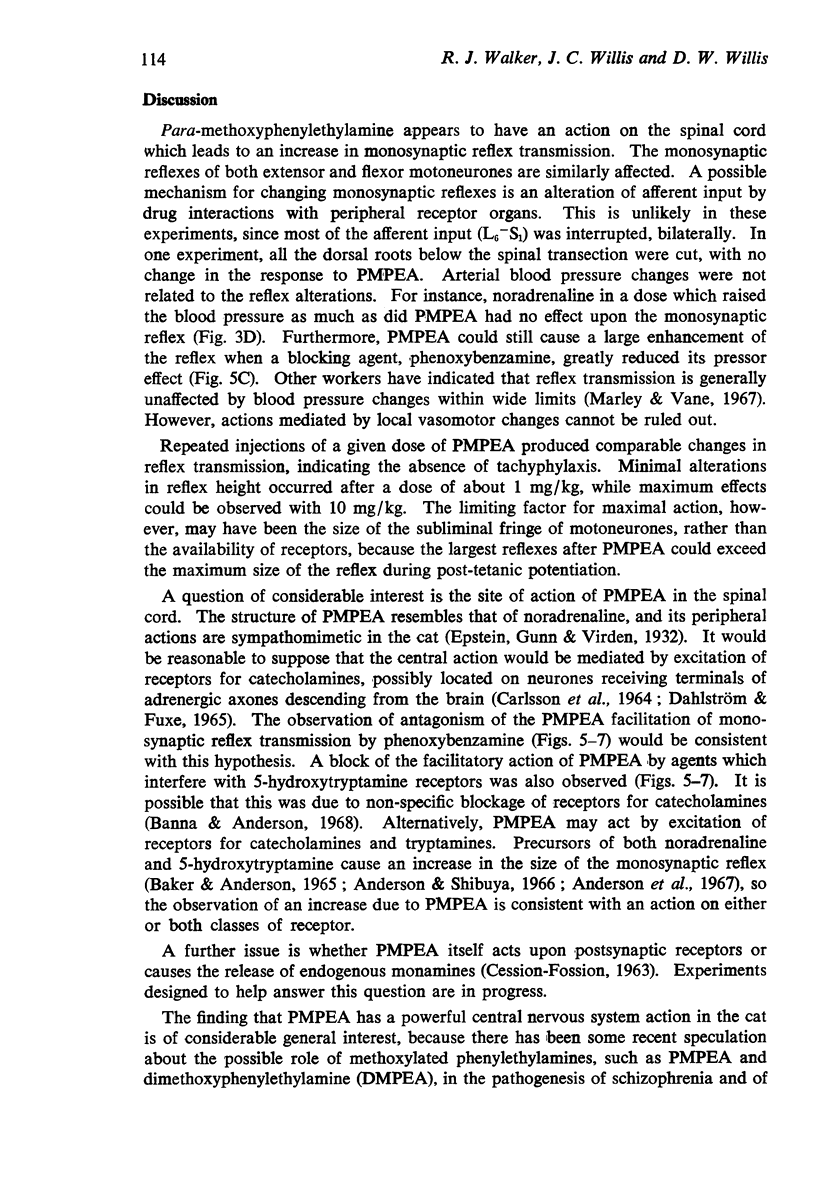
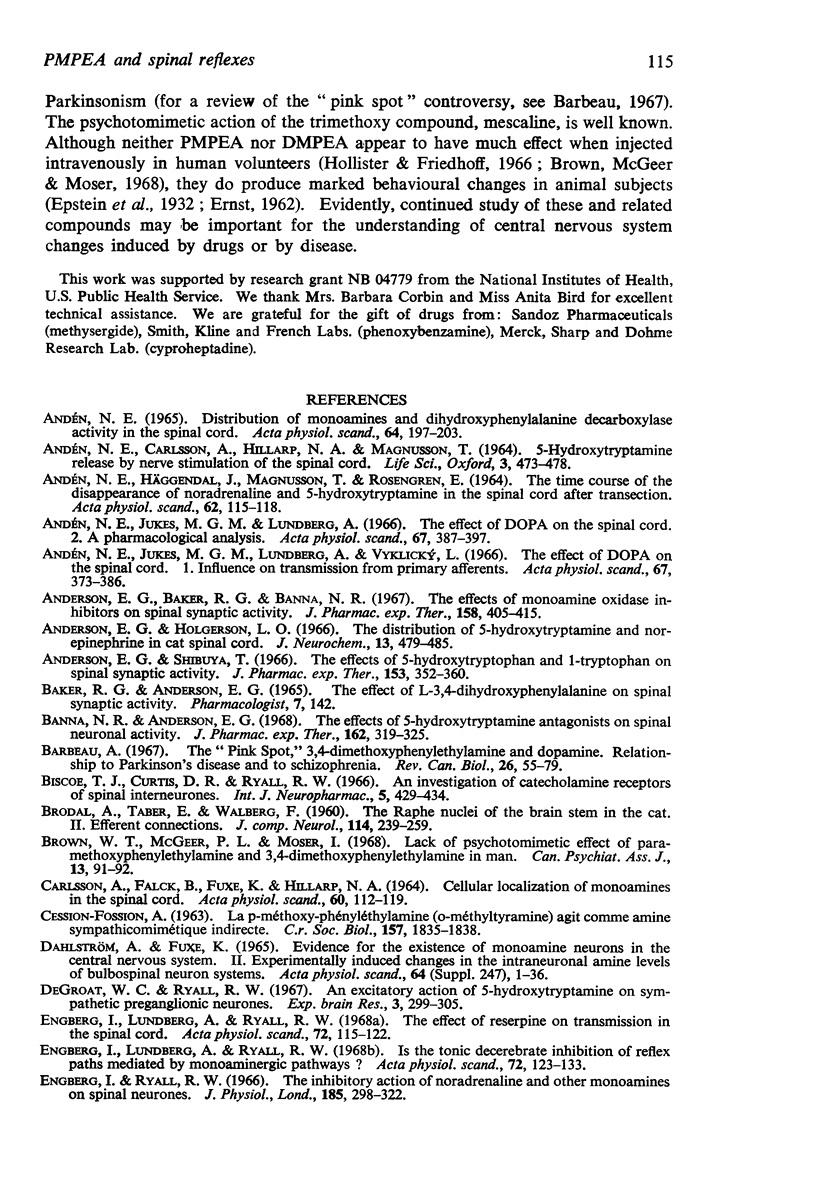

Selected References
These references are in PubMed. This may not be the complete list of references from this article.
- ANDEN N. E., CARLSSON A., HILLARP N. A., MAGNUSSON T. 5-HYDROXYTRYPTAMINE RELEASE BY NERVE STIMULATION OF THE SPINAL CORD. Life Sci. 1964 May;3:473–478. doi: 10.1016/0024-3205(64)90208-5. [DOI] [PubMed] [Google Scholar]
- ANDEN N. E., HAEGGENDAL J., MAGNUSSON T., ROSENGREN E. THE TIME COURSE OF THE DISAPPEARANCE OF NORADRENALINE AND 5-HYDROXYTRYPTAMINE IN THE SPINAL CORD AFTER TRANSECTION. Acta Physiol Scand. 1964 Sep-Oct;62:115–118. doi: 10.1111/j.1748-1716.1964.tb03958.x. [DOI] [PubMed] [Google Scholar]
- Anderson E. G., Baker R. G., Banna N. R. The effects of monoamine oxidase inhibitors on spinal synaptic activity. J Pharmacol Exp Ther. 1967 Dec;158(3):405–415. [PubMed] [Google Scholar]
- Anderson E. G., Holgerson L. O. The distribution of 5-hydroxytryptamine and norepinephrine in cat spinal cord. J Neurochem. 1966 Jun;13(6):479–485. doi: 10.1111/j.1471-4159.1966.tb09862.x. [DOI] [PubMed] [Google Scholar]
- Andén N. E. Distribution of monoamines and dihydroxyphenylalanine decarboxylase activity in the spinal cord. Acta Physiol Scand. 1965 Jul;64(3):197–203. doi: 10.1111/j.1748-1716.1965.tb04168.x. [DOI] [PubMed] [Google Scholar]
- Andén N. E., Jukes M. G., Lundberg A. The effect of DOPA on the spinal cord. 2. A pharmacological analysis. Acta Physiol Scand. 1966 Jul-Aug;67(3):387–397. doi: 10.1111/j.1748-1716.1966.tb03325.x. [DOI] [PubMed] [Google Scholar]
- Andén N. E., Jukes M. G., Lundberg A., Vyklický L. The effect of DOPA on the spinal cord. 1. Influence on transmission from primary afferents. Acta Physiol Scand. 1966 Jul-Aug;67(3):373–386. doi: 10.1111/j.1748-1716.1966.tb03324.x. [DOI] [PubMed] [Google Scholar]
- Banna N. R., Anderson E. G. The effects of 5-hydroxytryptamine antagonists on spinal neuronal activity. J Pharmacol Exp Ther. 1968 Aug;162(2):319–325. [PubMed] [Google Scholar]
- Barbeau A. The "pink spot", 3,4-dimethoxyphenylethylamine and dopamine. Relationship to Parkinson's disease and to schizophrenia. Rev Can Biol. 1967 Mar;26(1):55–79. [PubMed] [Google Scholar]
- Brown W. T., McGeer P. L., Moser I. Lack of psychotomimetic effect of para-methoxyphenylethylamine and 3,4-dimethoxyphenethylamine in man. Can Psychiatr Assoc J. 1968 Feb;13(1):91–92. doi: 10.1177/070674376801300117. [DOI] [PubMed] [Google Scholar]
- CARLSSON A., FALCK B., FUXE K., HILLARP N. A. CELLULAR LOCALIZATION OF MONOAMINES IN THE SPINAL CORD. Acta Physiol Scand. 1964 Jan-Feb;60:112–119. doi: 10.1111/j.1748-1716.1964.tb02874.x. [DOI] [PubMed] [Google Scholar]
- CESSION-FOSSION A. LA P-M'ETHOXY-PH'ENYL'ETHYLAMINE (O-M'ETHYLTYRAMINE) AGIT COMME AMINE SYMPATHICOMIM'ETIQUE INDIRECTE. C R Seances Soc Biol Fil. 1963;157:1835–1838. [PubMed] [Google Scholar]
- De Groat W. C., Ryall R. W. An excitatory action 0f 5-hydroxytryptamine on sympathetic preganglionic neurones. Exp Brain Res. 1967;3(4):299–305. doi: 10.1007/BF00237556. [DOI] [PubMed] [Google Scholar]
- ERNST A. M. Phenomena of the hypokinetic rigid type caused by o-methylation of dopamine in the para-position. Nature. 1962 Jan 13;193:178–179. doi: 10.1038/193178b0. [DOI] [PubMed] [Google Scholar]
- Engberg I., Lundberg A., Ryall R. W. Is the tonic decerebrate inhibition of reflex paths mediated by monoaminergic pathways? Acta Physiol Scand. 1968 Jan-Feb;72(1):123–133. doi: 10.1111/j.1748-1716.1968.tb03834.x. [DOI] [PubMed] [Google Scholar]
- Engberg I., Lundberg A., Ryall R. W. The effect of reserpine on transmission in the spinal cord. Acta Physiol Scand. 1968 Jan-Feb;72(1):115–122. doi: 10.1111/j.1748-1716.1968.tb03833.x. [DOI] [PubMed] [Google Scholar]
- Engberg I., Ryall R. W. The inhibitory action of noradrenaline and other monoamines on spinal neurones. J Physiol. 1966 Jul;185(2):298–322. doi: 10.1113/jphysiol.1966.sp007988. [DOI] [PMC free article] [PubMed] [Google Scholar]
- Epstein D., Gunn J. A., Virden C. J. The action of some amines related to adrenaline: I. Methoxy-phenylethylamines. J Physiol. 1932 Oct 4;76(2):224–246. doi: 10.1113/jphysiol.1932.sp002923. [DOI] [PMC free article] [PubMed] [Google Scholar]
- GOERANSSON G. THE METABOLISM OF FATTY ACIDS IN THE RAT. VI. ARACHIDONIC ACID. Acta Physiol Scand. 1965 May-Jun;64:1–5. doi: 10.1111/j.1748-1716.1965.tb04148.x. [DOI] [PubMed] [Google Scholar]
- Hollister L. E., Friedhoff A. J. Effects of 3,4-dimethoxyphenylethylamine in man. Nature. 1966 Jun 25;210(5043):1377–1378. doi: 10.1038/2101377b0. [DOI] [PubMed] [Google Scholar]
- Marley E., Vane J. R. Tryptamines and spinal cord reflexes in cats. Br J Pharmacol Chemother. 1967 Nov;31(3):447–465. doi: 10.1111/j.1476-5381.1967.tb00411.x. [DOI] [PMC free article] [PubMed] [Google Scholar]
- McLennan H. The effect of some catecholamines upon a monosynaptic reflex pathway in the spinal cord. J Physiol. 1961 Oct;158(3):411–425. doi: 10.1113/jphysiol.1961.sp006777. [DOI] [PMC free article] [PubMed] [Google Scholar]
- Phillis J. W., Tebecis A. K., York D. H. Depression of spinal motoneurones by noradrenaline, 5-hydroxytryptamine and histamine. Eur J Pharmacol. 1968 Nov;4(4):471–475. doi: 10.1016/0014-2999(68)90037-x. [DOI] [PubMed] [Google Scholar]
- Shibuya T., Anderson E. G. The influence of chronic cord transection on the effects of 5-hydroxytryptophan, l-tryptophan and pargyline on spinal neuronal activity. J Pharmacol Exp Ther. 1968 Nov;164(1):185–190. [PubMed] [Google Scholar]
- Walker R. J., Willis J. C., Willis W. D. The effect of p-methoxyphenylethylamine (PMPEA) on monosynaptic reflexes in the cat. Br J Pharmacol. 1969 May;36(1):198P–199P. [PMC free article] [PubMed] [Google Scholar]
- Weight F. F., Salmoiraghi G. C. Responses of spinal cord interneurons to acetylcholine, norepinephrine and serotonin administered by microelectrophoresis. J Pharmacol Exp Ther. 1966 Sep;153(3):420–427. [PubMed] [Google Scholar]


